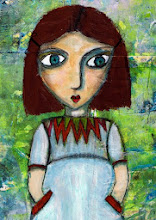 Here are three more of the arches I made for the "DivineFeminine" swap.
Here are three more of the arches I made for the "DivineFeminine" swap. The background for the image on the left is part of a strip collage. I took paper remnants and cut them into wedge shaped strips that I then glued onto a background sheet. The entire sheet was then painted green, to pull the scraps together and make them homogenous. Here, I stamped leaves and blooms onto the collage background and embossed them with clear embossing powder before applying the images. I made the wire embellishment in the peak using a pegboard.
 The little girl looked divine to me. She is probably around eight or nine, which is a magical age: they have such confidence in the life ahead of them and still believe they can do and be anything. I imagined her writing her life in the book, and I added the wings so that she would always know she could fly, whatever....
The little girl looked divine to me. She is probably around eight or nine, which is a magical age: they have such confidence in the life ahead of them and still believe they can do and be anything. I imagined her writing her life in the book, and I added the wings so that she would always know she could fly, whatever....
 This card contrasts with the girl card. Here, the divine woman is a young adult, crowned, but embedded in a life from which she looks out into the world.
This card contrasts with the girl card. Here, the divine woman is a young adult, crowned, but embedded in a life from which she looks out into the world.













